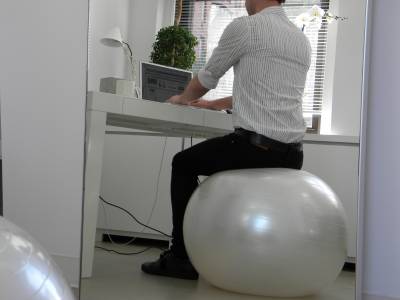Office Healthy Habits - 5 things you can do to reduce your risk
Tuesday, April 7, 2015

Now we know from the available research that just the simple act of sitting for long periods is really bad for you. It is responsible for an increased risk of a range of diseases and even premature death! So even in the most beneficial of office set ups, it is still bad! So, how can we combat this?
The solution sounds simple because it is - MOVE. Dynamic office environments are the healthiest environments we can place ourselves in for long periods. To back up this concept, fantastic research coming out of Australia indicates that an upright office suite can significantly reduce office strain injuries. Now, all we have to do it replicate what is going on here in our own environments.
1) Make a Healthy Habit out of Ordinary Tasks
Let's use photocopying as one example. If you need to make a copy in the office, promise yourself that every time you go to the Xerox machine, you do three stretches whilst waiting for it to finish. You can create an entire healthy program right in your office! Try adding a stretch to these mundane tasks:
- Every time an email is sent stretch your fingers
- Each time you go to the toilet do 10 squats
- Each time you have a coffee stretch your back
You get the picture! Now go and create your own program and pin it to your office wall. Get others in the office to do the same and you can really have some fun with it.
Note: there are some great apps on the internet that interrupt your working day to remind you to do some stretches. Jump online and download one if you are forgetful or need some added help!

2) Create a Symmetrical Office
Whilst the ergonomic pictures we often see give you a great concept of items to check from side on, it is important to think about things on your desk in the way that they are arranged from left to right. Are you equally using your left and right hands? Is your head constantly rotating towards one direction? By creating symmetry we can:
- Keep our spines in better alignment
- Reduce the occurrence of headaches
- Improve shoulder function
- Reduce the risk of carpal tunnel
3) Ignore the Sitting Rules!
Now this one is controversial. Sitting is bad for our bodies in general. And yes, the guidelines of correct sitting (pushing your lower back into the lumbar support, using a foot stool etc etc) all sounds great. But we are forgetting one thing! MOVING! If we sit still, with our lower backs supported by lumbar supports in our chairs, we are doing a lot of harm to our CORE STABILITY.
Our CORE is made up of small internal muscles in our abdomen and lower back. They hold us upright and try to assist in supporting our spine to prevent pain. When these muscles are asked to rest for long periods (such as using a back support) they weaken. And when they weaken, when we then ask them to do a lot of work (like gardening) they cannot help us to the extent we need them and they fatigue. Once they fatigue, we can become injured. Torn muscles, disc bulges and facet locking are just a few lumbar spine conditions.
To prevent this, try the following:
- Regularly change your sitting position to allow some muscles to work and other to rest.
- Try sitting on the edge of your seat, with an erect lumbar spine. It is a core workout in itself.
- Try sitting on a swiss ball whilst at work, your abs and lower back will love you!
- Try an ergonomic kneeling seat.
- Stand regularly, maybe every time you are on the phone!
With each of these small steps, be sure to introduce them slowly into your routine. You may need to recondition your lower back and CORE to work for you. This can take a few weeks to get used to.

3) Watch that Pen!
People often ask “How did I throw my back out when I was just picking up a pen?” They need to be reminded that it wasn't the pen or piece of paper that lead to their back injury, it was the neglect prior. All those years of sitting and losing your core muscles.
Our backs are designed to bend and bend well. We shouldn't keep them straight all of the time. But there is a time and place for training this!
Basic exercises like walking have a huge amount of evidence suggesting their injury prevention benefits! Have a chat to your physiotherapist about some more specific examples tailored to you.
4) Gossip Around the Water Cooler
Well, not quite! But get plenty of water into you. Experts believe that increasing hydration can actually assist you in reducing repetitive strain injuries. Dehydrated muscles, discs and joints are ineffective in their roles, and so they are at risk of being injured.
Taking regular water breaks throughout the day and consuming small quantities regularly is a great place to start. Coffee and tea are the normal drinks of choice for just about any office, but unfortunately the diuretic nature of caffeine when taken in large quantities can cause dehydration rather than hydration. Stick to one to two cups per day and you should be fine. As for water quantities, a litre is good if you are having other fluids like tea or coffee, as well as a good balanced diet. Too much water can actually dehydrate you!
The additional perk of going to the water cooler is that it's great for your lower back and legs!
